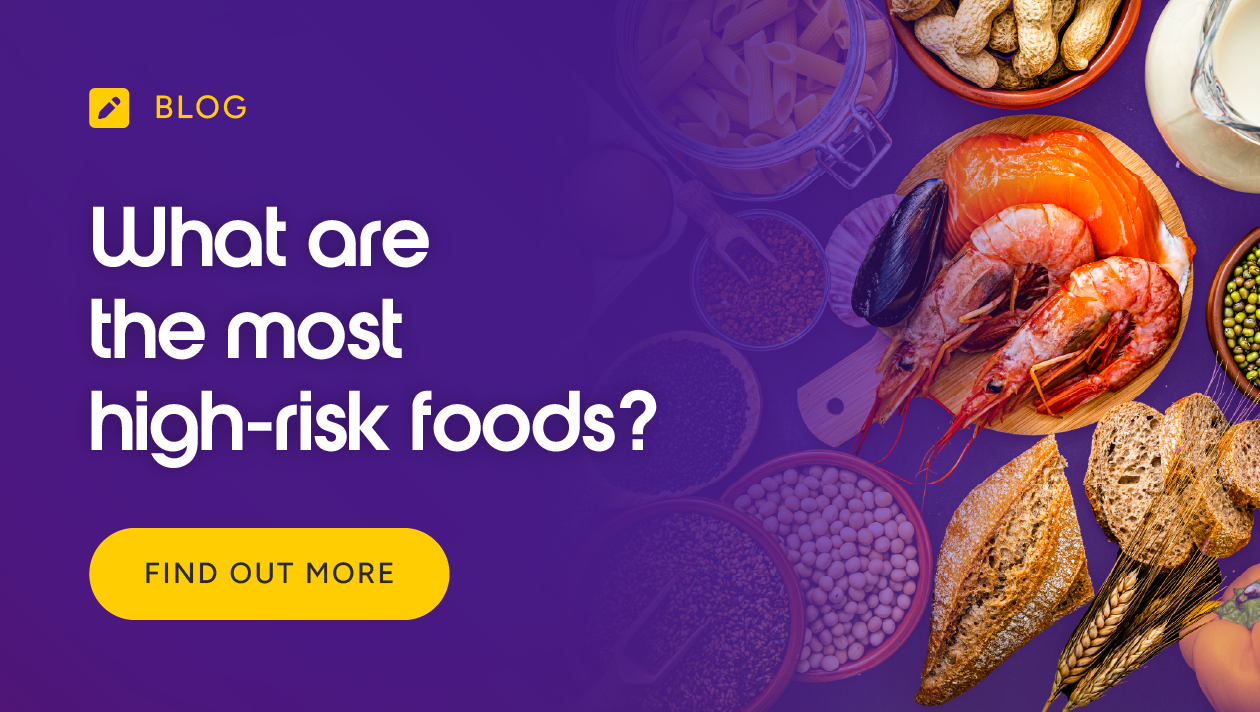What are the most high-risk foods?
Posted 7 years ago

Whether you’re preparing food at home, running a café, or working in a commercial kitchen, food safety should always be a top priority. One of the most important things to understand is which foods carry the highest risk, and why they need to be handled with extra care.
According to the Food Standards Agency (FSA), more than 2.4 million cases of foodborne illnesses were recorded in the UK in 2022. While not all of these were linked to high-risk foods, many could have been prevented with better food hygiene and storage practices.
So, in this blog, we’ll break down what high-risk foods are, what makes them more prone to contamination, and how to keep them safe to keep you safe in turn.
What does the term ‘high-risk foods’ mean?
When we say a food is ‘high-risk’, we mean it’s more likely to cause food poisoning if it’s not handled, stored, or prepared properly.
These are the kinds of foods that bacteria love — they offer the right conditions for harmful microorganisms to grow quickly, which is why extra care is needed when working with them.
Here’s what typically makes a food high-risk:
- They contain a lot of moisture
Bacteria need water to grow, so foods with a high water content – like cooked rice, dairy products or ready-made salads – can become unsafe if they’re not kept at the right temperature. - They’re high in protein
Protein-rich foods such as meat, poultry, eggs and seafood provide the perfect environment for bacteria to multiply. Without proper handling, these foods can become dangerous surprisingly quickly. - They have a neutral or slightly acidic pH
Most bacteria thrive in foods that aren’t too acidic or too alkaline. Foods like cooked meats and soft cheeses fall into this category and can easily support bacterial growth if not stored correctly. - They’re often ready to eat
Many high-risk foods are eaten without being cooked or reheated – think cold meats, sandwiches, or desserts. This means there’s no final step to kill off any bacteria, so safe handling is essential.
Because these foods are so vulnerable to contamination, anyone working with them – whether in a kitchen, café or food production setting – needs to be confident in their food hygiene knowledge and follow best practices every step of the way.
Common types of harmful bacteria found in high-risk foods
When it comes to high-risk food, bacteria can spread scarily fast. This means you’ve always got to be careful when handling and preparing it. Otherwise, you might encounter:
- Salmonella – Contamination and undercooking generally cause this common type of food poisoning. 2,500 people with salmonellosis in the UK are admitted to hospital each year.
- Campylobacter – This is the most common cause of food poisoning in the UK, which mainly stems from undercooked poultry meats.
- Escherichia coli 0157 (E. coli) – E. coli causes potentially fatal harm to the elderly and children. You can prevent this by cooking meat thoroughly.
- Listeria – This type of bacteria is found in raw milk (and milk products) and processed meats. Listeriosis can often survive the cold temperatures of a fridge and can only be killed once food is cooked, which makes it more of a threat.
- Clostridium Perfringens – Causing nearly one million illnesses each year, this is the third most common cause of foodborne illness in the UK & USA. This bacteria is found in meals of large quantities that are warmed for an extended period of time before serving. Catering companies are usually responsible for the spread of this bacteria due to feeding many people at once.
Have a look at some of our recent food hygiene blog posts related to the preparation of food to see how to reduce the chance of spreading these bacteria and causing illnesses!
Examples of high-risk foods
Certain foods are more likely to cause food poisoning because they naturally support the growth of harmful bacteria, especially when they’re ready to eat or not stored properly. These foods need careful handling and strict hygiene controls to keep them safe.
Animal products
These are among the most common high-risk foods due to their high protein and moisture content – ideal conditions for bacterial growth.
- Cooked meats (e.g. roast chicken, sliced ham): Once cooked, meats no longer have the heat barrier to kill bacteria. If they’re left out too long or not stored correctly, they can quickly become unsafe to eat.
- Poultry: Raw and cooked poultry can carry bacteria like Salmonella and Campylobacter. Improper handling or undercooking increases the risk of foodborne illness.
- Dairy products (e.g. milk, cream, soft cheeses): These items spoil quickly if not kept cold, and can harbour Listeria or E. coli, especially if they’re unpasteurised.
- Eggs: Raw or lightly cooked eggs can carry Salmonella, especially if they’re not Lion-marked or have been contaminated through handling.
Seafood
Seafood, particularly when eaten raw or only lightly cooked, carries a higher risk of contamination due to its environment and perishability.
- Shellfish (e.g. mussels, oysters): These can absorb bacteria and viruses from polluted water, making proper sourcing, storage and preparation essential.
- Smoked fish (e.g. smoked salmon): Though it’s preserved, smoked fish still needs refrigeration and can carry Listeria monocytogenes, which is particularly dangerous for vulnerable groups.
Cooked rice and pasta
It might surprise some, but these carbohydrate-rich foods can also be high-risk once cooked.
- Cooked rice and pasta: When left at room temperature, cooked rice can develop Bacillus cereus, a heat-resistant bacterium that survives cooking. Reheating doesn’t always make it safe again. Proper cooling and refrigeration is key.
Prepared salads and sandwiches
These often contain a mix of high-risk ingredients and are typically eaten without any further cooking.
- Pre-made salads: Items like coleslaw, potato salad, or leafy greens with dressings can support bacterial growth, especially when not stored properly or handled with unclean utensils.
- Sandwiches: Ready-to-eat sandwiches may contain cooked meats, dairy, and salad — all of which are vulnerable to contamination if not handled and stored correctly.
Ready-to-eat foods
Anything that doesn’t require further cooking before being eaten is especially risky, because there’s no final heat step to kill off bacteria.
- Cold meats and pâté: These are often consumed straight from the fridge and may contain Listeria if temperature controls fail.
- Soft cheeses (e.g. brie, camembert, blue cheese): These are more prone to harbouring harmful bacteria, particularly when made from unpasteurised milk.
- Pre-prepared desserts (e.g. cream cakes, trifles): These often contain dairy and are stored cold, making them susceptible to bacteria if chilled incorrectly or kept too long.
How does contamination occur, and how can it be prevented?
Contamination can happen at any stage — from preparation to serving. Understanding how it occurs is the first step in stopping it.
Common causes of contamination
- Cross-contamination
This happens when bacteria spreads from one surface or food to another — e.g. using the same chopping board for raw chicken and ready-to-eat salad without cleaning it first. - Poor temperature control
If high-risk foods are kept in the ‘danger zone’ (usually between 8°C and 63°C), bacteria can multiply fast. Not chilling or reheating food properly is a common issue. - Poor storage
Storing cooked and raw foods together, failing to seal food properly, or not rotating stock (first in, first out) can all contribute to contamination. - Poor personal hygiene
Unwashed hands, dirty uniforms, and not covering cuts or wounds can introduce harmful bacteria directly into food.
How to prevent contamination
- Handle food safely
Always use separate utensils and equipment for raw and cooked foods, and follow clear hygiene procedures when preparing meals. You can avoid cross-contamination by using colour-coded chopping boards for different food types (e.g. red for raw meat and green for veggies) - Store food properly
Keep cold foods cold (below 5°C) and hot foods hot (above 63°C). It’s that simple. Make sure food is labelled and covered, and raw foods are stored below cooked items in the fridge so, if something leaks, no raw meat drips down onto other food. It’s also important to regularly check food expiry dates and follow the correct rules when it comes to disposing of expired products. - Clean regularly and thoroughly
Work surfaces, equipment and hands should be cleaned and sanitised regularly, especially after handling raw food. It’s beneficial to add a cleaning rota that’s visible to all staff so everyone can see when areas were last cleaned, and by who. - Train your team
Anyone working with food should have up-to-date food safety training so they understand their responsibilities and can confidently put best practices into action. This could include refresher courses, encouraging open communication within the team so they can ask for help on things they’re unsure of, or even offering protocols for reporting illnesses or incidents.
By following these simple steps, food handlers and businesses can dramatically reduce the risk of contamination and keep their customers safe!
What are the legal requirements around high-risk foods?
Food safety isn’t just best practice: it’s a legal requirement.
In the UK, anyone who works with food has a duty to protect the public from harm. This applies whether you’re preparing meals in a school kitchen, working in a restaurant, or running a food business from home.
The key legislation includes:
- The Food Safety Act 1990
This outlines the basic responsibilities of anyone involved in the production, handling or sale of food, including anyone responsible for ensuring food is safe to eat and honestly described. - The Food Hygiene Regulations 2006
These regulations focus specifically on hygiene practices. They include rules around food handling, cleanliness, temperature control and record keeping.
One of the most important principles for food businesses is due diligence. This means doing everything that’s reasonably possible to keep food safe, including having proper procedures in place, keeping records, and ensuring all staff are properly trained.
By following the law and taking food safety seriously, businesses not only protect their customers, but also build trust and reduce the risk of legal action, fines or reputational damage.
Food Safety & Hygiene Training
Here at iHasco, we offer three online Food Safety & Hygiene Training courses:
- Food Safety & Hygiene Level 1 Training
- Food Safety & Hygiene Level 2 Training
- Food Safety & Hygiene Level 3 Training
Pretty straightforward!
Level 1 and level 2 courses are for anyone who works where food is made, sold, or served. They give you a good understanding of food hygiene and how to handle consumables properly.
Level 3 training is for managers or supervisors and provides a more advanced, in-depth level of training.
To sweeten the deal even more, we also offer an Online Food Allergy Awareness Training course that covers allergens, food law and how to avoid cross-contamination!
All of our food-related courses have an IOSH approval, for that extra guarantee of the quality of our course. But why not see for yourself? Try our course for free today!
This is quite an interesting course that has opened my mind clearly in many things with regards to preparing foods as a Caterer. It has refreshed my mind and has also improved my professional level.

Jack Rosier
Senior Marketing Executive
Related articles



Opt-in to our newsletter
Receive industry news & offers